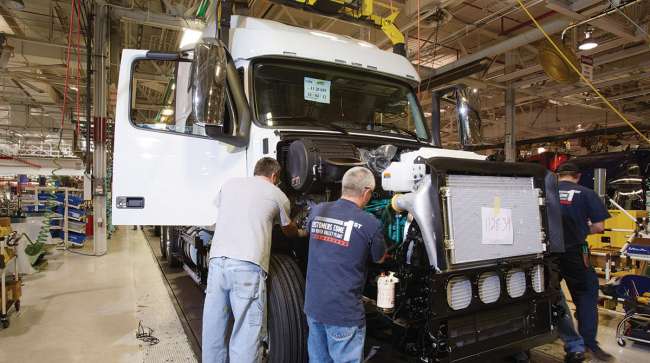Senior Reporter
North American Class 8 Orders Up 424% to 40,000 in March

[Stay on top of transportation news: Get TTNews in your inbox.]
Preliminary North American Class 8 net orders in March were 40,000 units, up an impressive 424% compared with the COVID-impacted intake a year earlier, ACT Research reported, citing truck makers’ nearly complete but preliminary data.
March 2020 orders had dropped to 7,632, according to ACT.
“Despite retrenching from February [44,191 orders], ACT Vice President Steve Tam said, “Class 8 demand remained strong in March, well above replacement and even anticipated economic growth, let alone the industry’s ability to keep pace in the current supply chain constrained environment.”
Preliminary NA Class 8 net orders in March were 40,000 units, down 10% from February, but a whopping 424% higher than March of last year’s COVID-stricken intake. https://t.co/t9t5F8eTdv#truck #semitruck #trucking #transportation pic.twitter.com/FAINl1HbzI — ACT Research (@actresearch) April 5, 2021
Class 8 replacement level for North America is considered to be 19,000 orders a month.
FTR pegged preliminary orders at 40,800.
“Orders continue to flow into OEMs at a record pace” and have since October, said Don Ake, FTR vice president of commercial vehicles. “To have this level of orders roll in for half a year is impressive and unprecedented.”
Ake said orders may remain high going forward because Class 8 backlogs are not up to the level they were in 2018 and 2019 when orders came in a pattern similar to now.
“So there’s still some room to grow,” he said. “We don’t expect the numbers to stay high forever, but we could still see a couple of months of elevated orders.”

Clark
Dan Clark, head of BMO Transportation Finance, said orders continue to reflect the freight market’s overall strength and elevated freight rates.
“Combining the freight market’s strength with the need to attract scarce drivers with new equipment, “ Clark said, “we expect wait times to remain extended, and likewise, cancellations to remain muted as fleets lock in their build slots.”
One truck dealer executive said he believes most OEMs’ order boards are tight, if not already sold out for 2021. Also, truck prices are rising and customers are seeing other increased costs in their operations.
“The current backlog situation is not helping any dealer group right now,” said Robert Gomez, executive vice president of sales for Worldwide Equipment. “Dealers will need to rely on selling used equipment.”
Only 14.3% of the truck driver population is made up of African Americans, followed by 13% Hispanic, and 7% Asian. In this episode, host Michael Freeze wonders what industry leaders are doing to increase those percentages. We talk to two trucking industry experts who have implemented their own practices that are contributing to a more diverse work community. Hear a snippet, above, and get the full program by going to RoadSigns.TTNews.com.
Worldwide is a multibrand, multilocation medium- and heavy-duty truck dealership based in Prestonsburg, Ky.
“All the various vendor shortages will increase in the third and fourth quarter,” he said.
Customers are facing higher costs with fuel and delays on getting parts due to shortages, and with all this going on they are trying to keep their drivers happy, often through pay increases, he said.
“So I think they understand [delays and higher prices], they may not like it, but they understand. But a customer is still a customer and will try to get their best deal,” Gomez said.
“We are upfront, fair and honest with our customers and educate and communicate as best we can — margins may have slipped, which is OK,” he added. “Our customer base has stayed strong because we have been true to our customers. So we just have to weather the storm.”
Meanwhile, Bridgestone announced it will increase prices by 8% on Firestone brand truck and bus radial tires sold in the U.S. and Canada. The new pricing will take effect May 1 and is in response to continued escalating raw material costs.
That announcement followed a price increase up to 8% on Bridgestone brand truck and bus radial tires and Bandag retreads that went into effect April 1.
In related news, Paccar Inc. recently reported the semiconductor shortage reduced its truck deliveries in the first quarter by 3,000 vehicles.
Assuming there is no COVID-19 resurgence, Paccar’s forecast for 2021 truck industry retail sales remained unchanged in the U.S. and Canada. Sales are expected to be 250,000 to 280,000 units compared with 216,500 in 2020.
Paccar is the parent company of the Peterbilt Motors Co., Kenworth Truck Co. and DAF (Europe) brands.

Volkmann
Equity analyst Stephen Volkmann with Jefferies wrote in a note he viewed Paccar’s news positively “given that the company maintained its full-year outlook and is bottlenecked due to supply.”
“This demand imbalance should elongate the cycle further and drive higher pricing of trucks over time,” Volkmann wrote.
Ake noted each Class 8 can use 15 to 35 microchips depending on “what you have on it and what’s computerized on it. If you don’t have chips, you have obvious production problems.”
Shortly after the preliminary March industry order numbers were released, Daimler Trucks North America announced its Class 8 Freightliner eCascadia and medium-duty eM2 are available to order.
Start of production is scheduled for late 2022, according to the Portland, Ore.-based company.
DTNA said the maximum range for the eM2 will be 230 miles on a full charge and 250 miles for the eCascadia tractor.
Want more news? Listen to today's daily briefing below or go here for more info:


